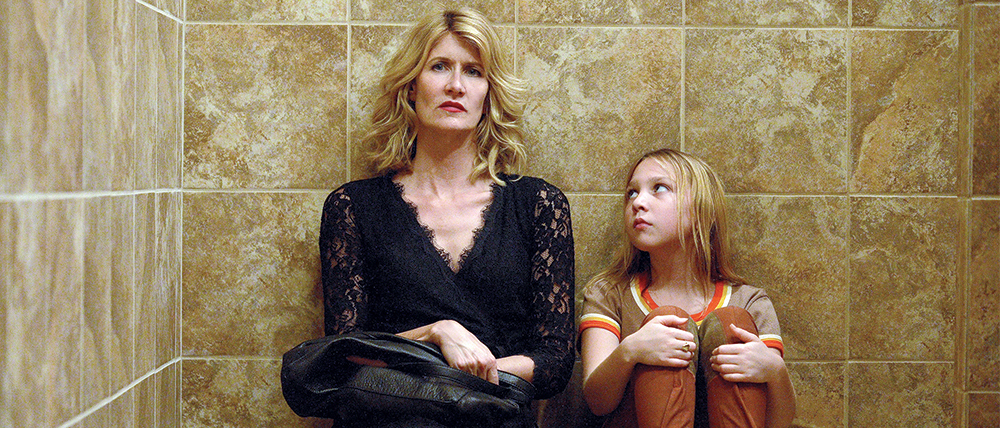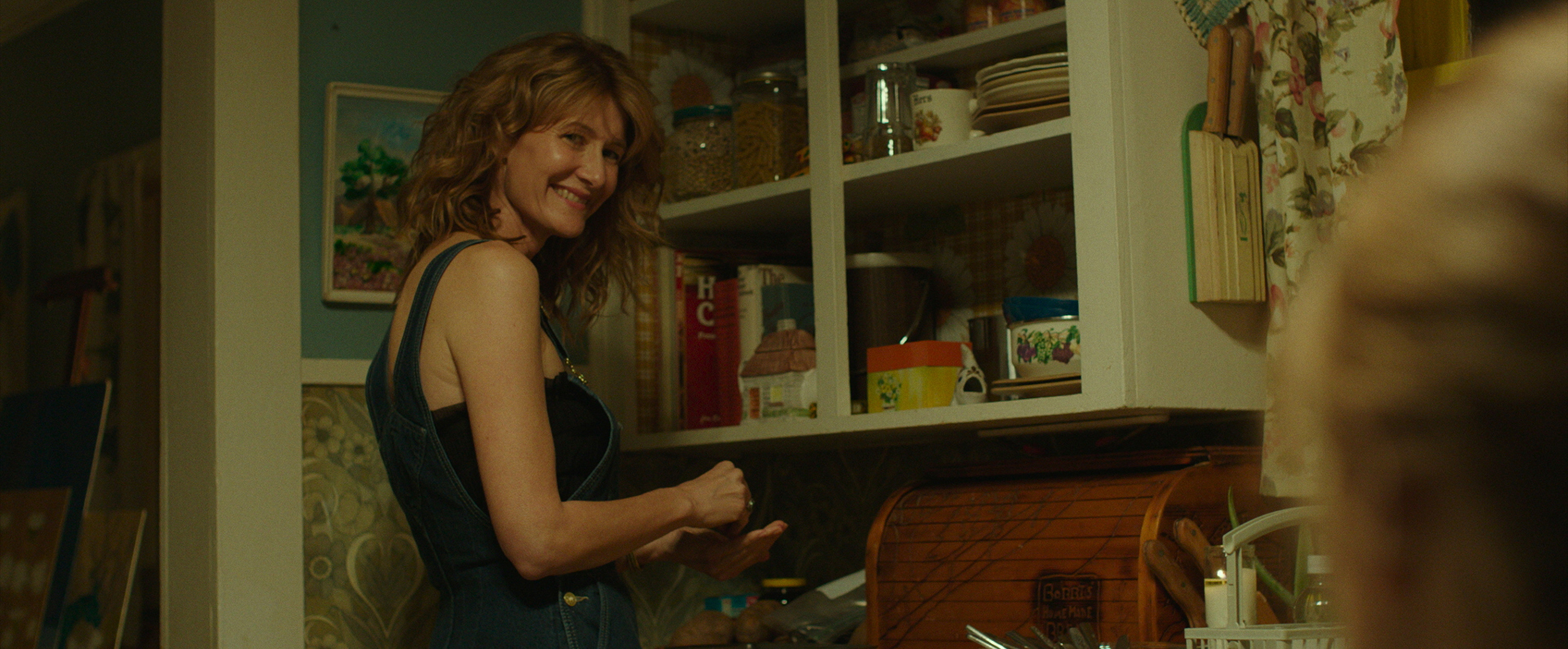
Dark, Distant Memories: The Tale
Denis Lenoir, ASC, AFC deftly employs diffusion and depth to accentuate his visual approach to this indie drama, which was completed by Ivan Strasburg, BSC.
Denis Lenoir, ASC, AFC deftly employs diffusion and depth to accentuate his visual approach to this indie drama, which was completed by Ivan Strasburg, BSC.
Screening in competition at the recent Sundance Film Festival was the narrative feature The Tale, photographed by Denis Lenoir, ASC, AFC and Ivan Strasburg, BSC. The story follows Jennifer, a New York journalist and professor (played by Laura Dern) whose life is turned upside down when her mother finds a story that Jennifer wrote as a 13-year-old girl, detailing a “special” relationship with her horseback riding coaches. The underpinnings of the story shake Jennifer badly. There’s a deep and disturbing connotation here that contradicts with Jennifer’s memories of events, and she decides to return to her hometown in Carolina to confront her old coaches and uncover the truth.
“The script is based on a true story that happened to the writer-director, Jennifer Fox,” explains Lenoir. “It centers on a sexual abuse that happened in her childhood and the story is told in present day and also in flashbacks as Jennifer begins to remember more details about her childhood.
“It was a very strong script,” continues the cinematographer. “The director had previously done documentaries and this was her first narrative feature.”
Shot on location in Shreveport, Louisiana, in November of 2016, the project had a modest budget. To visually depict the story, Lenoir decided to break the script down into five sections, each denoting a different time period and stage of evolution in Jennifer’s discovery. The specific approach for each section incorporated different diffusion filtration, depth of field, camera height to subject and lens choices.

“I came up with five looks, which I labeled A, B, C, D and E. Each different section represents a different movement in the story and in the drama,” Lenoir explains. “I decided to go with shallow depth of field for the adult Jennifer, but more depth of field for the young Jenny. A higher camera position for the grown up Jennifer, and a lower camera position for Jenny, things like this. After I had defined the five looks, I refined them into just three. Because A is a relatively normal look, B is a bit down from there and C is ultimately the darkest and then D was a lot like B and E was a lot like A — I reduced it to just A, B and C looks.”
Below is a portion of a document that Lenoir created during prep, detailing this methodology:
Jfer A
• higher camera – longer lenses (50mm and above) – shallow DoF (wide open if possible) – SFX2/UC1 – BPM ¾ - LUT A (slightly lower contrast and higher color saturation).
Jny A
• lower camera – wider lenses (40mm and under) – deep DoF (T4 if possible) – SFX2 – BPM ¾ - LUT A (slightly lower contrast and higher color saturation).
Jfer B
• higher camera – longer lenses (50mm and above) – shallow DoF (wide open if possible) – SFX1/UC1 – BPM ¼ - LUT B (regular contrast and color saturation)
Jny B
• lower camera – wider lenses (40mm and under) – deep DoF (T4 if possible) – SFX1 – BPM ¼ - LUT B (regular contrast and color saturation)
Jfer C
• higher camera – longer lenses (50mm and above) – shallow DoF (wide open if possible) – SFX ½ /UC1 – BPM 1/8 – LUT C (slightly higher contrast and lower color saturation).
Jny C
• lower camera – wider lenses (40mm and under) ) – deep DoF (T4 if possible) – SFX ½ - BPM 1/8 - LUT C (slightly higher contrast and lower color saturation).
Each of the three looks had a slightly different approach to adult Jennifer in present day and young Jenny (played by Isabelle Nélisse) in flashbacks.
A significant player in the look of the project was Lenoir's choice in filtration. As noted above, the cinematographer chose a combination of Tiffen Soft/FX (SFX), Tiffen Black Pro-Mist (BPM) and Tiffen Ultra Contrast (UC) filters.
“I don’t use the Soft/FX and Black Pro-Mist together,” asserts Lenoir. “Rather I use Soft/FX for interiors and Black Pro-Mist for exteriors — this is something I've done for a long time. I don't normally diffuse a wide frame; not landscapes or establishing shots, but something day exterior that is closer than mid-thigh or something, I would use a Pro-Mist. Interiors I often use a Soft/FX filter, sometimes combined with an Ultra Contrast. Years ago, I learned that Tiffen will custom manufacture any combination of filters into one piece of glass for the same price as the normal filter, so I had a whole set of filters made that are various combinations of Soft/FX and Ultra Contrast and I use them all the time.
“The Soft/FX filter is unlike older diffusion filters that I had been using,” the cinematographer continues. “They’re very good at breaking up the sharpness of the image but not too heavy in contrast loss or flare. At the same time, I had noticed in my experience that a wrinkle or a pimple on the skin is a matter of contrast as well. Just diffusing sharpness wasn’t enough. You can make it less focused, but if you also have less contrast between the shadow created by the wrinkle and the other part of skin next to it — it will be less visible. From that moment, for cosmetic reasons, I began to use these two filters in combination — Soft/FX and Ultra Contrast — to have great control over sharpness and softness.”
In creating his LUTs, Lenoir attests, “I generally develop them quickly. I try to create a basic LUT on the day of the makeup test or on day one of shooting. My approach is just to give the editors and the director something that is in the right direction. I’ll go farther by sending images to the dailies colorist: screen captures that I will color quickly at night or stills that I shoot on set — not necessarily something that they should reproduce exactly, but more to give them the idea of what I’m looking for and a direction to go. I know that my images won’t be perfectly right — it's not the right monitor, the blacks won’t be correct, but I tell them to trust their eye and use these images as a guide. This way the director has something that more closely approximates what we want when they’re looking at dailies and editing. This way, when we get into the final grading session, changing to the look we want won't be drastic change for the director and we'll already be a long way toward our final goal.”
In the flashback sequences the narrative revisits a summer camp where young Jenny learned to ride horses. For several of these sequences Lenoir employed a jib arm with the base at the center of the ring or coral in order to photograph the actresses on horseback.
“I rarely put any light outside at day,” the cinematographer attests. “Unless it’s absolutely necessary. Eventually people are going to be in a car or under a porch and you have to push a little sunlight in there, but, in general, I find it unnecessary. This film, in particular, had to be charming in some ways. The story gets very dark, but it has to start from a light place to get dark. I think the overall emotional impact on the audience is stronger if the visuals are more idyllic and bucolic. It makes what happens even creepier, but you don’t want to go from Technicolor to skip bleach — the level of change between the different parts needs to be more subtle. I love to give a story a visual arc; it’s something that I do on almost every movie. But, hopefully, no one is going to notice it — it’s meant to be subtle support of the drama and nothing more.”
In the course of the shoot, a family emergency required Lenoir to leave the production with about two thirds of the project shot. Through their mutual agent, the production hired Ivan Strasburg to take over the rest of the show.
“I knew Denis socially as we share the same agent,” offers Strasburg. “Denis had set up The Tale and he was already in his third week or so of shooting when I got called in. I find taking over from another DP not that difficult. The biggest problem is getting the credit for something of theirs that looks really terrible. On the other hand, they get credit for anything of yours which they think is terrible. In this case, though, that’s not a worry because Denis’ work is fantastic. I had just arrived in Austin, Texas, to begin work on a series that got postponed for a few months so I was free and in the neighborhood. My agent asked me if I would like to take over for Denis and I headed off to Shreveport and arrived on the Friday night before having to shoot the following Monday. I spent the weekend driving around with Jennifer to look at the various locations and get up to speed.
“I had a quick look at some of the dailies, just to get a good idea of what Denis had been doing, and fell straight in with his crew and LUTs,” Strasburg continues. “I didn’t deliberately change what he had been doing because it was already the way I would have done it, anyway. Fortunately, the crew were very good so it all seemed pretty seamless.”
A significant challenge for Strasburg on The Tale was photographing a scene depicting the sexual abuse of a 13-year-old girl by an adult male. “Understandably, the various authorities — SAG-AFTRA, Social Services, etcetera — forbid a whole series of possible stagings,” explains Strasburg. “For example, we couldn’t have them lying in the same bed together. So we got around this by hanging a mattress vertically and having Isabelle standing on a box against the mattress with the man standing facing her a couple feet away. Then we shot over his shoulder with a long lens to make it look like he was lying on her.”
For a final small portion of the production that shot in Los Angeles in the summer of 2017, neither Lenoir nor Strasburg was available, so cinematographer James Chressanthis, ASC finished out the schedule.
“This was Jennifer’s first narrative feature with actors, but she was a fast learner and good to work with,” concludes Strasburg. “We were helped an enormous amount by a really talented cast, especially Isabelle. She was capable of the subtlest changes in her performance. What amazed me was that I never thought she was listening between takes as she was invariable messing about, but she was always spot-on when the camera was rolling.”
Technical Specifications
| Aspect Ratio | 1.85:1 |
| Sensor | Digital Capture |
| Camera | Arri Alexa HS |
| Lenses | Summilux-C Primes |
| Primo Optimo 15-40mm | |
| Primo 11:1 24-275mm |
The will debut on HBO on May 26.
This article was produced as part of the media partnership between AC and Canon in conjunction with the Sundance Film Festival. You'll find more of our coverage here.







